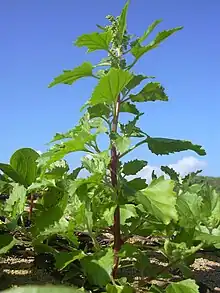Chenopodiastrum
Chenopodiastrum is a genus of herbaceous flowering plants in the family Amaranthaceae. The genus was formally described in 2012.[2] [3] The 5 species occur in Eurasia, North Africa, and North America.[3]
| Chenopodiastrum | |
|---|---|
 | |
| Chenopodiastrum murale | |
| Scientific classification | |
| Kingdom: | Plantae |
| Clade: | Tracheophytes |
| Clade: | Angiosperms |
| Clade: | Eudicots |
| Order: | Caryophyllales |
| Family: | Amaranthaceae |
| Subfamily: | Chenopodioideae |
| Tribe: | Atripliceae |
| Genus: | Chenopodiastrum (L.) S.Fuentes, Uotila & Borsch[1] |
| Species | |
|
See text | |
| Synonyms | |
| |
Description
The species in genus Chenopodiastrum are non-aromatic annual herbs. Young plants have vesicular trichomes, that later collapse and fall down, thus plants becoming glabrescent. Stems grow erect, with lateral branches. The alternate leaves have a petiole and a thickish triangular, ovate, rhombic-ovate to lanceolate leaf blade. The leaf margin can be irregularly dentate or lobed, or pinnatifid with narrow dentate lobes.
The axillary and terminal inflorescences consist of small dense glomerules of flowers, arranged spicately or paniculately. Flowers are bisexual or pistillate. They contain 5 basally connate perianth segments with a prominent keel near the apex, and a characteristic strong midrib visible from the inside; a circle of 5 stamens; and an ovary with 2 stigmas.
In fruit, the perianth lobes enclose the fruit or spread. The membraneous pericarp adheres firmly to the seed. The horizontally orientated seeds are lenticular. The black seed coat is often prominently pitted, sometimes rugulose or nearly smooth.
Systematics and distribution
The genus Chenopodiastrum was described in 2012 by Suzy Fuentes-Bazan, Pertti Uotila und Thomas Borsch (in: A novel phylogeny-based generic classification for Chenopodium sensu lato, and a tribal rearrangement of Chenopodioideae (Chenopodiaceae). in Willdenowia 42, p. 14). After phylogenetic research, this group of species had to be separated from genus Chenopodium, that would otherwise have been polyphyletic.[2] The genus Chenopodiastrum belongs to the same tribe as Chenopodium, Tribus Atripliceae.[2]
Chenopodiastrum consists of 5 species,[2] occurring in Eurasia, North Africa, and North America:
- Chenopodiastrum badachschanicum (Tzvelev) S.Fuentes, Uotila & Borsch, (syn. Chenopodium badachschanicum Tzvelev): In Middle Asia, China, northeastern Afghanistan, northern Pakistan, northern India and Nepal.[4]
- Chenopodiastrum coronopus (Moq.) S.Fuentes, Uotila & Borsch, (syn. Chenopodium coronopus Moq.): endemic on Canary Islands, Ilhas Selvagens, and probably Madeira.[5]
- Chenopodiastrum hybridum (L.) S.Fuentes, Uotila & Borsch (syn. Chenopodium hybridum L.):[6] in Europe, India and from temperate Asia to China.[3]
- Chenopodiastrum murale (L) S.Fuentes, Uotila & Borsch (syn. Chenopodium murale L. ):[7] in Europe, North Africa and Southwest Asia.[3]
- Chenopodiastrum simplex (Torr.) S.Fuentes, Uotila & Borsch (syn. Chenopodium hybridum var. simplex Torr.):[8] in North America.[3]
References
- "Chenopodiastrum". International Plant Names Index (IPNI). Royal Botanic Gardens, Kew; Harvard University Herbaria & Libraries; Australian National Botanic Gardens. Retrieved 7 July 2013.
- Fuentes-Bazan, Susy; Uotila, Pertti; Borsch, Thomas (2012). "A novel phylogeny-based generic classification for Chenopodium sensu lato, and a tribal rearrangement of Chenopodioideae (Chenopodiaceae)". Willdenowia - Annals of the Botanic Garden and Botanical Museum Berlin-Dahlem. 42 (1): 5–24. doi:10.3372/wi42.42101. ISSN 0511-9618.
- "Genus: Chenopodiastrum S. Fuentes et al". Germplasm Resources Information Network (GRIN). United States Department of Agriculture, Agricultural Research Service, Beltsville Area. Archived from the original on 3 December 2013. Retrieved 7 June 2013.
- Chenopodium badachschanicum In: Helmut Freitag et al.: Chenopodiaceae. In: Flora of Pakistan, Volume 204 - Missouri Botanical Garden Press & University of Karachi.
- Pertti Uotila, 2011: Chenopodiaceae (pro parte majore): Chenopodium coronopus – In: Euro+Med Plantbase - the information resource for Euro-Mediterranean plant diversity, retrieved 2 July 2013
- International Plant Names Index (IPNI). Royal Botanic Gardens, Kew; Harvard University Herbaria & Libraries; Australian National Botanic Gardens https://www.ipni.org/n/77121009-1. Retrieved 7 July 2013.
{{cite web}}: Missing or empty|title=(help) - International Plant Names Index (IPNI). Royal Botanic Gardens, Kew; Harvard University Herbaria & Libraries; Australian National Botanic Gardens https://www.ipni.org/n/77121007-1. Retrieved 7 July 2013.
{{cite web}}: Missing or empty|title=(help) - International Plant Names Index (IPNI). Royal Botanic Gardens, Kew; Harvard University Herbaria & Libraries; Australian National Botanic Gardens https://www.ipni.org/n/77121011-1. Retrieved 7 July 2013.
{{cite web}}: Missing or empty|title=(help)
External links
- "Chenopodiastrum". National Center for Biotechnology Information (NCBI).
- Chenopodiastrum at Tropicos
![]() Media related to Chenopodiastrum at Wikimedia Commons
Media related to Chenopodiastrum at Wikimedia Commons
![]() Data related to Chenopodiastrum at Wikispecies
Data related to Chenopodiastrum at Wikispecies